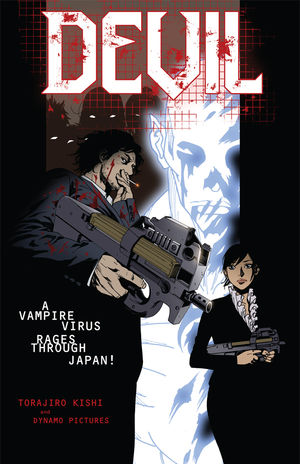Today I take a look at "Devil" by Torajiro Kishi, and Dynamo Pictures.
A few months ago, when Border's Books started going out of business, myself and countless other comic book nerds flocked to the emptying store to take advantage of the liquidation prices. Most of the popular titles got snatched up pretty quick, leaving many books that I'd never heard of. In the instance of "Devil", a random pick turned out to be a pretty decent purchase.
"Devil" is somewhat a rarity in several respects. It was written AND illustrated by Torajiro Kishi, giving the art and story a powerful unity that can be rather hit or miss with collaboration comics. Also, while the art style would probably be labeled as "manga", the book itself was designed and published under American comic sizes and standards. This makes the book far easier to read for manga fans who might not have caught on to the right to left reading format yet.
The story takes place in Japan, in a future not far off, where a new virus has started turning people into superhuman bloodsuckers known as "Devils". Now, before you write this off as another stupid vampire comic, you should know that "Devil" provides a rather fresh take on the vampire phenomenon. For one, these Devils don't sparkle. Big plus there.
Through following the lives of Detectives Takimoto and Migiwa of the Devil Investigation Section of the Tokyo Police Force, we begin to realize that the Devils are an accident of over ambitious science, and humanity is mostly helpless to offer aid to the victims off this virus. This tale also brings up a fascinating point about human existence; We humans have no predators. We've essentially removed ourselves from the circle of life, and instead of our lives focusing on "How do we survive?", we're only concerned with, "How should we spend our lives?". Knowing that, what would occur if a new predator was introduced into the equation? The underlying fear in "Devils", is that in such a scenario, the human race would eventually be wiped out.
This comic is definitely not for kids. It's a good ol' Japanese spatter fest, complete with blood explosions and rather nightmarish imagery. The art style is a pleasantly detailed mixture of manga-eqsue characters and more Western style inking and coloring. I was particularly impressed with the detail shown to all the various weapons and machinery involved in the comic, as well as the original design of the "Devils". Instead of sparkly humans with pointy teeth, you get glowing skeletal figures, seemingly having their flesh burned off by their own internal energy.
Overall, the premise of this story is fascinating enough that I would like to read more. Sadly, I don't feel quite enough was revealed in the 4 issues available at the moment. It's a great teaser, but I'd be truly disappointed if Kishi and Dark Horse Books don't have plans for continuing this series. It was a great read to get on sale, but given its lack of continuation at this time, I'd check it out at the library.
TL;DR - INTERESTING STORY IDEA, BUT NEEDS MORE ISSUES BEFORE CONCLUDING.

